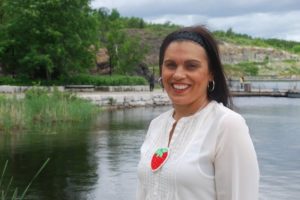Celebration: Family, health and water move Goudreau forward

By Laura E. Young
SUDBURY—When Ghislaine Goudreau first brought the Anishnaabe-Kweg Water Walk Journey to Sudbury in 2005, she was reportedly the only person to carry water the 20-kilometre loop around Sudbury’s Lake Ramsey.
In fall 2017, the Water Walk will mark its 12th anniversary. The walk highlights the important role Anishnaabe women have as carriers of water, with plenty of walkers to share the load.
Goudreault is a member of Algonquins of Pikwàkanagàn and has always lived in Sudbury. She has been a health promoter at the Sudbury & District Health Unit since 2001. Her prize-winning Master’s thesis is rooted in Aboriginal women’s hand drumming and health promotion. She is also a member of the Waabishki Mkwaa (White Bear) Singers.
She recently was part of another reunion that united both sides of her family heritage.
After her grandmother emerged from 10 years in the residential school in Spanish, she became pregnant. She was unable to care for her two children, Goudreau’s father and brother. His brother was adopted into a First Nation’s family on Manitoulin Island; Goudreau’s father went to a French-Canadian family in Sudbury.
After searching for decades, they located her uncle’s family in 2016. They reunited last year in Michigan.
“Growing up, I did not know anything about my culture. I only really started to understand my history and culture when I took an Indigenous studies course in university,” recalls Goudreau. “This was the first time I learned about residential schools and what they were intended to do.”
She began to pursue as many educational opportunities as she could in order to learn more. She took part in ceremonies during her studies at Laurentian University. She also facilitates a children’s drum circle which her sons attend.
After completing her physical education degree in health promotion in the late 1990s, she began working as a health promoter at the Shkagamik-Kwe Health Centre. She facilitated culturally significant and health promotion activities, especially the Aboriginal women’s hand drumming circles, learning and growing with the other women.
After three years at the centre, she returned to Laurentian to pursue a Master’s degree in health promotion. During her studies, she had a vision to write a thesis about Aboriginal women’s hand drumming.
“This vision was not easy to achieve because there were many obstacles along the way,” notes Goudrea. “Fortunately, I had a lot of support from the community, my thesis advisors, my family and the women’s hand drum circle whom I belong to.”
Being both First Nation and non-First Nation, Goudreau walks in both worlds. Still, she wishes all Canadians would make the effort to better understand the First Nations and what truly happened to them throughout Canadian history.
“When I hear people say to move on or that they don’t want to hear about Canadian history, I know they don’t understand the deep hurt that is still felt among Indigenous peoples,” notes Goudreau. “This genuine understanding is part of reconciliation that will help end racism and oppression that affects generations of Indigenous peoples, families and communities.”
Goudreau, also affectionately known as G, has often been held up as a role model in the Sudbury community; yet it’s her goal that her dark-eyed sons, both under the age of 10, consider their mom as their role model.
“They are there with me at and during my best and my worst and see how I deal with the good and bad,” she says.
She also wants them to find pride in their Algonquin heritage.
“Indigenous people need many allies to help us thrive,” states Goudreau. “We can help lead the way in many areas such as health, education, and environment. Canadians just needs to paddle alongside us and not try and steer our canoe.”
Editor’s Note: What’s in a role model? Who is a role model? Is it a cliché? Is it patronizing or do so-called role model stories become necessary to balance the tide of negative stories? In this ongoing series, Ontario’s Indigenous women reflect on that term role model when they have a moment between their work serving in education, health, justice, and social work.


